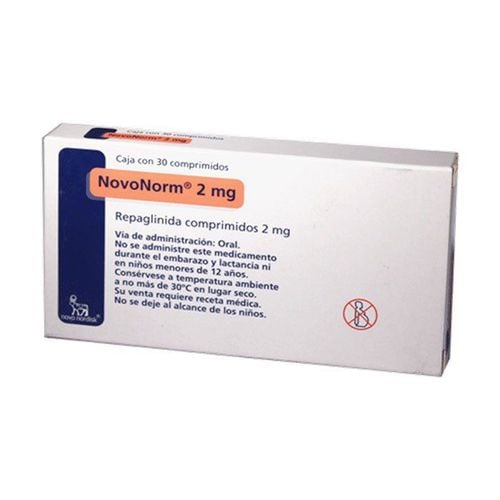This is an automatically translated article.
Glumerif 4 is a drug that lowers blood sugar by stimulating the body to produce insulin from the beta cells of the pancreas. When using drugs to ensure safety, you need to understand the drug and the precautions when taking it.
1. What is Glumerif 4?
The active ingredient Glumerif is Glimepiride 4mg. Glimepiride is a new generation of sulfonylurea-lowering drugs. The hypoglycemic effect of the drug is achieved mainly by stimulating the release of insulin by pancreatic beta cells. Glimepiride acts by stimulating the closure of ATP-dependent potassium channels in the membranes of beta cells. Closing of this potassium channel causes membrane depolarization, increasing intracellular calcium movement. Increasing intracellular calcium levels induces the release of insulin from the cells.In addition, glimepiride has extra-pancreatic effects through the following mechanisms:
Glimepiride improves the sensitivity of peripheral tissues to insulin and thereby increases the effectiveness of insulin. The drug reduces the absorption of insulin in the liver. Glimepiride stimulates glucose uptake into muscle and adipose tissue. The hydroxy metabolites of glimepiride also have a mild hypoglycaemic effect. Thus, through many mechanisms of action, Glimepiride is effective in lowering blood sugar and is used to treat non-insulin dependent diabetes. The drug is used alone or in combination with other drugs when used for patients who do not have good control of blood sugar levels with changes in diet and exercise.
2. Points to note when taking Glumerif 4
Taking blood sugar-lowering drugs often requires long-term use and to ensure safety and effectiveness you need to be aware of the following things after taking the drug.
2.1 Contraindications Glumerif 4 should not be used if the patient has the following conditions:
Type 1 diabetes, also known as insulin-dependent diabetes mellitus, diabetic ketoacidosis. Pre-coma or diabetic coma; Severe kidney failure and severe liver failure; Patients with hypersensitivity to glimepiride, to other sulfonylureas, other sulphonamides and to any of the excipients; Women who are pregnant or planning to become pregnant and should not be used by women who are breastfeeding. Pregnant women can cause harm to the fetus when used, should not use the drug and if planning to become pregnant should change to another type. Breastfeeding is not recommended for nursing women while taking this medicine. 2.2 Notes on side effects of Glumerif 4 When taking Glumerif 4, you may encounter the following undesirable effects:
Very common side effects are hypoglycemia, hemolytic anemia; Common: headache, dizziness, nausea, vomiting, abdominal pain, diarrhea; Temporary visual disturbance. Uncommon: Allergic or pseudo-allergic reactions, erythema, urticaria, pruritus. Rare: Causes increased liver enzymes, jaundice, impaired liver function; thrombocytopenia, decreased red blood cells, white blood cells, agranulocytosis; allergic vasculitis; sensitive to light. Inform your doctor about the unwanted effects you experience when using Glumerif 4
2.3 Notes on how to use Glumerif 4 You should take the medicine before the main meal of the day. Because drinking before meals to control blood sugar after meals. You must not skip meals immediately after taking the medicine as this causes drug-induced hypoglycemia. If you forget to take a dose, do not make up for it with a higher dose. This causes dose-induced hypoglycemia. A single overdose or long-term use of too high a dose can lead to severe, prolonged hypoglycemia, which can be life-threatening. Immediately notify a doctor and seek medical attention. It is necessary to adhere to the application of a strict diet. Check your blood sugar and urine sugar at regular intervals while taking the medicine. A low dose should be started to monitor response and reduce the risk of hypoglycaemia with dosing. Increase the dose after the indicated time, do not increase too quickly. 2.4 Risk of hypoglycemia when using Glumerif 4 Because the drug has a stimulating effect on insulin production, there is a risk of hypoglycemia when used. It should be noted that some people at risk of hypoglycemia include:
Patients with inadequate nutrition, elderly patients, patients with kidney or liver failure, hypopituitarism are prone to hypoglycemia and can be severe when taking Glimepiride. Patients who are under stress such as trauma, surgery, infection, high fever when treated with Glimepiride, blood sugar may also decrease, need to temporarily switch the drug to insulin. Patients should be closely monitored during the first weeks of initiation of therapy, as hypoglycemia may occur during this time. If individuals on the lowest dose of monotherapy are still hypoglycemic, drug discontinuation and strict dietary modification should be considered.
2.5 Administering medications to drivers or operating machinery c During episodes of hypoglycaemia or hyperglycemia, especially when initiating or changing therapy or when glimepiride is not being administered on a regular basis, flexibility and patient response may be impaired. This may affect the ability to drive or use machines.
2.6 Drug Interactions Glumerif 4 when taken with other drugs can cause a change in the effect of the drug. Some drugs need to be careful when taking, including:
Drugs that increase the hypoglycemic effect of glimepiride, which can cause mild to severe hypoglycemia: Insulin, other oral antidiabetic agents, inhibitors ACE inhibitors, anabolic steroids and male sex hormones, chloramphenicol, coumarin derivatives, cyclophosphamide, disopyramide, fibrate, fluoxetin, fenfluramine, fenyramidol, ifosfamide, MAO inhibitors, miconazole, para-aminosalicylic acid, pentoxifylline , phenylbutazone, azapropazone, oxyphenbutazone, probenecid, quinolones, salicylates, sulfinpyrazone, sulfonamides, beta-blockers, guanethidine, tetracycline, tritoqualine, trofosfamide. Drugs that can reduce the hypoglycemic effect of glimepiride such as: Diuretics, especially thiazide diuretics, corticosteroids, diazoxide, catecholamines and other sympathomimetic drugs; Glucagon; nicotinic acid (high dose); Estrogen and estrogen-containing birth control pills; Phenothiazines; Phenytoin; Thyroid hormone and the antibiotic Rifampicin Alcohol when taken together can make the side effects of glimepiride worse. Drinking alcohol while taking glimepiride may increase your risk of symptoms such as headache, nausea and vomiting, chest pain, weakness, blurred vision, mental confusion, sweating, trouble breathing, anxiety settle. Above are the points you need to keep in mind when taking Glumerif. To be safe, follow the doctor's instructions and read the drug information carefully before taking it.
Please dial HOTLINE for more information or register for an appointment HERE. Download MyVinmec app to make appointments faster and to manage your bookings easily.













